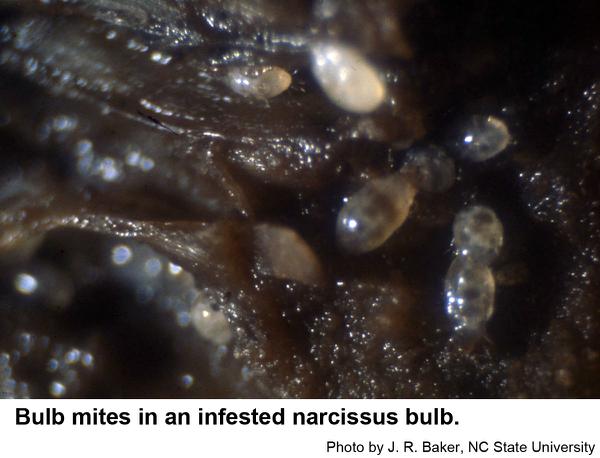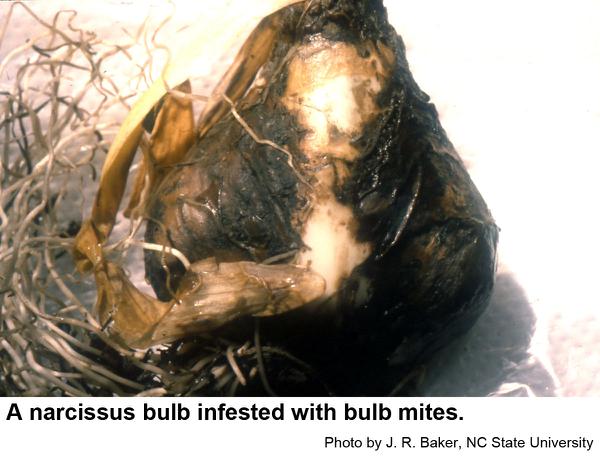Description and Biology
Bulb mites, Rhizoglyphus echinopus, are found all over the world damaging flowering and edible bulb crops. Other closely related species are also important: Rhizoglyphus robini, R. Hyacinthi, and R. engeli. Mature female bulb mites are tiny (about 1/32 inch long), white or transparent, smooth, and shiny. The legs are reddish brown. The eggs are very small, white, and shaped like a rugby football. Females can lay up to 700 eggs each. Five to 27 days later, from the eggs hatch extremely tiny, six-legged, oval larvae. The next stage, protonymphs are slightly larger and have four pairs of legs. Deutonymphs or hypopi are the next stage which is quiescent. Hypopi lack mouthparts and are capable of surviving harsh conditions. The final immature stage is the tritonymph that resembles the adult mite, but lacks a distinct genital aperture. The total life cycle from egg to adult in warm conditions lasts about 2 weeks. Adults may live 4 months at cooler temperature. Once inside a bulb, if a fungal pathogen is present in the soil, the combination of mites and fungus may soon turn the bulb into a rotten pulp. Bulb mites can even infest the stems of lilies, and infested lily plants are dwarfed, distorted, and stem roots are suppressed, if the plant survives at all. These mites can also survive on paper and other organic matter in soil.
Host Plants
Bulb mites have been recorded feeding on Eucharis, forced iris, Gloriosa, Hippeastrum, hyacinth, lily, orchid, narcissus, and tulip bulbs. Dahlia tubers as well as freesia and gladiolus corms are also infested as well as vegetable bulbs. Bulb mites by themselves are not particularly damaging, but if there is any trace of root-rotting fungi attacking the roots, bulb mites further injure the roots and make the rot root worse by penetrating the basal plate or outer skin layers. Feeding injury provides entry sites for soilborne fungal pathogens such as Pythium, Rhizoctonia, and Fusarium. By itself, these root rot fungi might only stunt the bulb, but in combination with bulb mites, infected bulbs may be totally destroyed. Bulb mites carry such pathogens on their bodies and may crawl from an infested bulb to a healthy bulb nearby. Because bulb mites require high relative humidity, bulbs in dry storage are usually not infested so it is not likely that bulb mites from dry bulbs such as those purchased at garden centers and big box stores will be introduced into the landscape. However, any spongy bulbs should be discarded.
Residential Recommendations
These mites can enter the slightest injury so bulbs should be handled with care. Don't jam a bulb into the soil, as that may injure it enough for bulb mites to gain entry. If bulb mites are affecting a section of a flower bed, the best management would be to dig up and discard the bulbs and start with fresh bulbs, gently planted the following fall. A prized bulb can be rescued by soaking it in hot water (110°F) for 30 minutes. This often weakens bulbs and should be used only as a last resort.
References
- Relationship of Rhyzoglyphus robini (Acari: Acaridae) to root rot control in greenhouse-forced Easter lilies. Ascerno, M. E. et al.. 1983. Environ. Entomol. 12: 422-5.
- Insect and Related Pests of Flowers and Foliage Plants. Baker, J. R. ed. 1994 (revised). N.C. Cooperative Extension Service pub. AG-136.
- Bulb Mites. Smith, T. 2011. UMass Extension, Greenhouse Crops & Floriculture Program. Enter for Agriculture, Food and the Environment. UMassAmherst.
- NC State Extension Plant Pathology Publications
- NC State Horticultural Science Publications
- North Carolina Agricultural Chemicals Manual
For assistance with a specific problem, contact your local N.C. Cooperative Extension center.
This factsheet has not been peer reviewed.
Publication date: Feb. 26, 2018
Reviewed/Revised: Dec. 2, 2022
N.C. Cooperative Extension prohibits discrimination and harassment regardless of age, color, disability, family and marital status, gender identity, national origin, political beliefs, race, religion, sex (including pregnancy), sexual orientation and veteran status.



